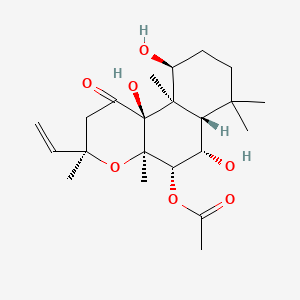| MeSH term | MeSH ID | Detail |
|---|---|---|
| Hemolysis | D006461 | 131 associated lipids |
| Diarrhea | D003967 | 32 associated lipids |
| Diabetes Mellitus | D003920 | 90 associated lipids |
| Hearing Loss, Sensorineural | D006319 | 8 associated lipids |
| Graft Occlusion, Vascular | D006083 | 11 associated lipids |
| Arrhythmias, Cardiac | D001145 | 42 associated lipids |
| Hypercalcemia | D006934 | 13 associated lipids |
| Neovascularization, Pathologic | D009389 | 39 associated lipids |
| Tumor Virus Infections | D014412 | 8 associated lipids |
| Adenocarcinoma | D000230 | 166 associated lipids |
forskolin
Forskolin is a lipid of Prenol Lipids (PR) class. Forskolin is associated with abnormalities such as Cholestasis, Vocal cord dysfunction familial, Hypothyroidism, Renal tubular disorder and Disintegration (morphologic abnormality). The involved functions are known as Cell Proliferation, Anabolism, mRNA Expression, Agent and Signal. Forskolin often locates in Extracellular, Body tissue, Skin, Tissue membrane and Membrane. The associated genes with forskolin are P4HTM gene, SLC33A1 gene, NR1I2 gene, Genes, Reporter and CYP3A gene. The related lipids are Steroids, steroid sulfate, Fatty Acids, LYSO-PC and Lipopolysaccharides.
Cross Reference
Introduction
To understand associated biological information of forskolin, we collected biological information of abnormalities, associated pathways, cellular/molecular locations, biological functions, related genes/proteins, lipids and common seen animal/experimental models with organized paragraphs from literatures.
What diseases are associated with forskolin?
forskolin is suspected in Cyst, Kozlowski Celermajer Tink syndrome, Vocal cord dysfunction familial, Alzheimer's Disease, Cholestasis, Renal tubular disorder and other diseases in descending order of the highest number of associated sentences.
Related references are mostly published in these journals:
| Disease | Cross reference | Weighted score | Related literature |
|---|
Possible diseases from mapped MeSH terms on references
We collected disease MeSH terms mapped to the references associated with forskolin
PubChem Associated disorders and diseases
What pathways are associated with forskolin
Lipid pathways are not clear in current pathway databases. We organized associated pathways with forskolin through full-text articles, including metabolic pathways or pathways of biological mechanisms.
Related references are published most in these journals:
| Pathway name | Related literatures |
|---|
PubChem Biomolecular Interactions and Pathways
Link to PubChem Biomolecular Interactions and PathwaysWhat cellular locations are associated with forskolin?
Visualization in cellular structure
Associated locations are in red color. Not associated locations are in black.
Related references are published most in these journals:
| Location | Cross reference | Weighted score | Related literatures |
|---|
What functions are associated with forskolin?
Related references are published most in these journals:
| Function | Cross reference | Weighted score | Related literatures |
|---|
What lipids are associated with forskolin?
Related references are published most in these journals:
| Lipid concept | Cross reference | Weighted score | Related literatures |
|---|
What genes are associated with forskolin?
Related references are published most in these journals:
| Gene | Cross reference | Weighted score | Related literatures |
|---|
What common seen animal models are associated with forskolin?
There are no associated biomedical information in the current reference collection.
NCBI Entrez Crosslinks
All references with forskolin
Download all related citations| Authors | Title | Published | Journal | PubMed Link |
|---|---|---|---|---|
| pmid: | ||||
| Mauriège P et al. | Is visceral adiposity a significant correlate of subcutaneous adipose cell lipolysis in men? | 1999 | J. Clin. Endocrinol. Metab. | pmid:10022446 |
| Giannetti N et al. | Somatostatin-dependent adenylyl cyclase activity in nonactivated and mitogen-activated human T cells: evidence for uncoupling of sst3 receptor from adenylyl cyclase. | 1999 | J. Cell. Biochem. | pmid:10022504 |
| Ng SS et al. | Real-time evaluation of human secretin receptor activity using cytosensor microphysiometry. | 1999 | J. Cell. Biochem. | pmid:10022611 |
| Touraine RL et al. | The bystander effect in the HSVtk/ganciclovir system and its relationship to gap junctional communication. | 1998 | Gene Ther. | pmid:10023450 |
| Hausman DB et al. | Endocrine regulation of fetal adipose tissue metabolism in the pig: interaction of porcine growth hormone and thyroxine. | 1999 | Obes. Res. | pmid:10023733 |
| Sutliff RL et al. | Phospholamban is present in endothelial cells and modulates endothelium-dependent relaxation. Evidence from phospholamban gene-ablated mice. | 1999 | Circ. Res. | pmid:10024311 |
| Kuromi H and Kidokoro Y | The optically determined size of exo/endo cycling vesicle pool correlates with the quantal content at the neuromuscular junction of Drosophila larvae. | 1999 | J. Neurosci. | pmid:10024343 |
| Rana S et al. | Synergistic activation of yeast-expressed rat androgen receptor by modulators of protein kinase-A. | 1999 | J. Mol. Biol. | pmid:10024442 |
| Sirianni MJ et al. | Cyclic AMP analogs induce synthesis, processing, and secretion of prepro nociceptin/orphanin FQ-derived peptides by NS20Y neuroblastoma cells. | 1999 | DNA Cell Biol. | pmid:10025508 |
